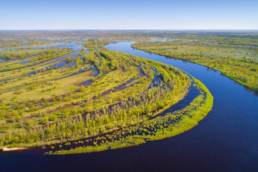New study: natural hydrological regimes are key for Polesia's resilience to devastating landscape fires
Landscape fires disproportionally affect areas of conservation priority but only under low moisture conditions - this is the conclusion of the new peer-reviewed study where scientists mapped and analyzed large fires that occurred over a 19-year period in Polesia, a region containing some of Europe’s last pristine peatlands and lowland forests in Eastern Europe.
Fires are of great concern to policymakers in the region due to the economic and health costs, and a lot of resources are used to suppress fires during hot and dry years. There are potentially natural solutions to fires, however, that could also benefit birds, biodiversity and climate issues. These ‘nature-based’ solutions include restoring drained wetlands. In this study, freely-available satellite data were used to explore the prevalence of large fires and the factors causing them. This allowed researchers to explore whether restoring the landscape’s wetlands could reduce the increasing risk of large, damaging fires as the climate changes.
This study identified five fires reaching more than 100 km2, a threshold often used to classify ‘megafires’. Frequent spring and summer fires predominantly started in agricultural areas, where farmers burn the land to clear it, both before planting and following the harvest. However, these fires often spread into neighbouring peatlands and floodplain meadows, endangering threatened wildlife, such as the Greater Spotted Eagle and Aquatic Warbler, and damaging a globally important carbon sink.

The largest fires burned in native deciduous forests, threatening protected old-growth oak and beech forests, which are more vulnerable and less likely to recover than more fire-adapted trees. Overall, more than one fifth of protected land burned. This is compared with 8% of unprotected land. One fire reached 97 km2 and burned significant areas of the Chernobyl Exclusion Zone, where radioactive contamination from the Chernobyl 1986 disaster is highest, and where the impacts of large fires on human health may be particularly severe.

The results of the study suggest that landscape restoration in Polesia’s wetlands would help to limit the spread and intensity of unnaturally large, damaging fires, while reinstating natural, periodic low-intensity fires, providing ecosystem benefits and supporting long-term carbon storage.
Throughout Europe, including in Polesia, years of drainage for agriculture and commercial forestry has created overgrown, drier landscapes that are more susceptible to fires. This study showed that open peatlands, meadows, and deciduous forests were far more likely to burn when moisture conditions in the soil and litter were low. In contrast, peatlands were very unlikely to burn under high moisture conditions. Preserving and restoring large, intact, well-hydrated peatlands would help to create natural barriers to large, severe fires, while reinstating periodic low-intensity fires. Doing so would provide ecosystem and conservation benefits, support long-term carbon storage and help tackle climate change, and protect human lives.







